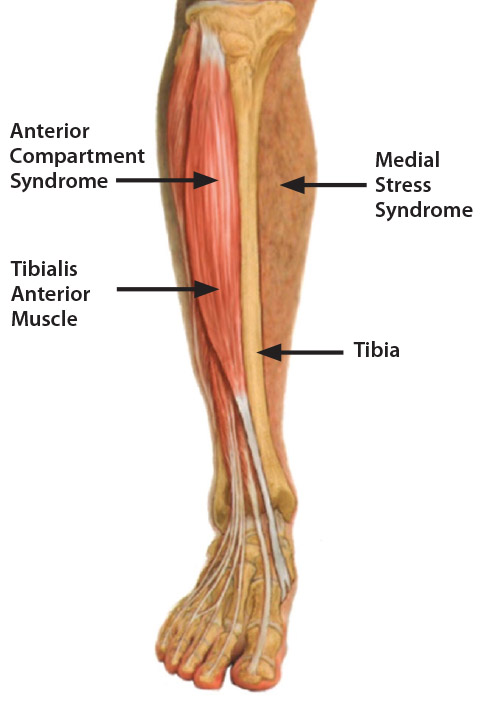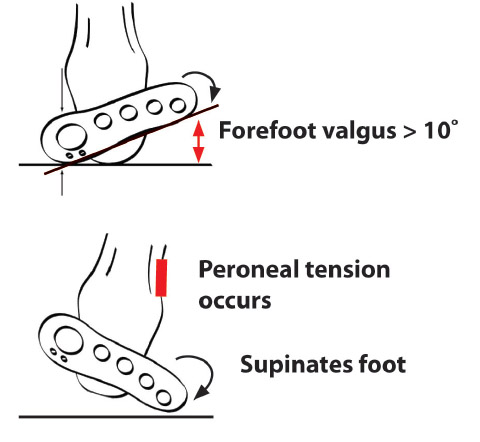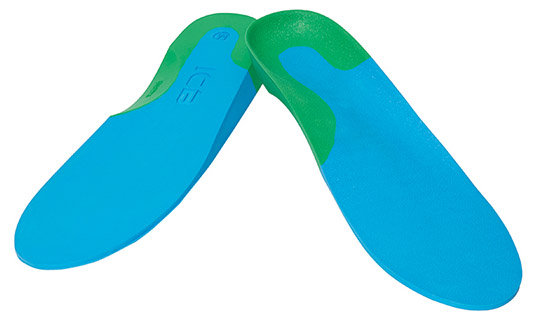Shin splints is often associated with highly active and sporting people. Shin splints is an over-use strain injury that can be directly attributed to excessive pronation or supination as the underlying causative factor. Shin pain can be experienced medially, laterally or anteriorly.
Biomechanical Aetiology
Medial Shin Splints: the Tibialis Posterior tendon may be tight and slip over the medial malleolar due to a weak retinaculum. This is generally associated with repetitive excessive subtalar joint pronation, causing the Tibialis Posterior tendon to elongate as the foot collapses medially, hence causing medial shin pain. The continual elongation of the Tibialis Posterior tendon can cause minut tears and scaring in the muscle belly whilst the pulling away from the tibia can cause inflammation and pain.
Lateral Shin Splints: The biomechanical characteristics of the foot may exhibit a high forefoot valgus or fixed plantarflexed 1st ray, both of which may cause a supinatory effect in the patient’s gait.
When the foot is supinated it causes extreme stress on the peroneals and may cause elongation of the muscles and tendons. The peroneals may may slip off the lateral melleolar anteriorly causing irritation of the tendon. This is associated with a weak retinaculum and tight peroneals trying to elongate to compensate for the forefoot valgus deformity – meaning that as the forefoot tries to make contact with the ground the foot is forced into supination, tearing or straining the peroneal muscles.
Anterior Shin Splints: There is evidence to suggest that anterior shin splints may be related to supination at heel strike, followed by pronation at the midstance to toe-off stage of gait. During the gait cycle the tibialis anterior muscle inverts the foot for ground clearance at the late swing phase. If there is a forefoot valgus < 10° the foot will supinate at heel strike and the ground reaction force on the lateral side will then throw the foot into pronation at midstance to toe-off. In this circrumstance the tibialis anterior will elongate and cause tearing at the muscle belly on the lateral tibial crest and may cause adhesion.
Symptoms
Medial Shin Splints: Often occur when walking for extended periods of time or running uphill. Pain is experienced along the tibialis posterior muscle and tendon. Sometimes it can be felt close to the inferior medial collateral ligament attachment, all the way down to the navicular area.
Lateral Shin Splints: Pain may be experienced when walking or running long distances, especially when doing so downhill. Being that most sufferers exhibit a forefoot valgus deformity, causing the foot supinate during the midstance phase of gait, the peroneal muscles can tear causing inflammation and tenderness to touch – in addition to pain being experienced when walking or running.
Anterior Shin Splints: Anterior shin pain is often experienced after running or walking on inclines and declines.
Treatment
Being that shin splints, medial, lateral and anterior, are linked to biomechanical dysfunction of the lower limb, long-term treatment (and pain relief) of shin splints will primarily involve prescribing orthotics to control excessive pronation and or supination, and the resultant effects on the lower limb. Other techniques can be incorporated into the treatment regime to assist in short-term pain relief, however orthotics should be worn to ensure a ongoing long-term result.
Additional Treatment
- R.I.C.E Technique: Rest – Ice – Compression – Evaluation, will assists in reducing inflammation.
- Deep tissue massage is an effective means to break down adhesions.
- ‘Suction Cup’ Therapy: also effective in the breaking down of adhesion – although the resultant bruising on the treatment area may be an undesired side-effect.
- Acupuncture at the point of pain can assist is breaking down scar tissue.
Head Office
Kirrawee NSW 2232
AUSTRALIA




